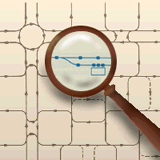 What is Personal Rapid Transit?
What is Personal Rapid Transit?
Personal rapid transit is a generally unknown and undeveloped subset of a class of transit systems known as Automated People Movers (APMs). Typical APM (i.e., non-PRT) systems generally consist of vehicles having capacities between 12 to 100 people which run along dedicated guideways in a line-haul, fixed-schedule, configuration. Examples of this type of system can be found in airport people-movers in U.S. cities such as Seattle, Dallas-Ft. Worth and Miami. Although fairly successful in these applications, APM systems have not been widely accepted as realistic modes of urban transport for many reasons, particulary with respect to PRT-type APMs. For PRT systems, some of these reasons include inertia within traditional transit sectors to consider new modes of transportation and inadequate testing of early prototype systems which led to highly publicized failures (see History of PRT). Furthermore, the definition of what comprises a PRT system has been clouded over the past thirty years, a fact that has helped to prevent serious research from being conducted in this area. In an effort to standardize the terminology, the Advanced Transit Association adopted in 1988 a set of guidelines that define a true PRT system.

An interior view of a hypothetical PRT vehicle.
In brief, the guidelines state that a PRT system should have:
- Fully automated vehicles capable of operation without human drivers.
- Vehicles captive to a reserved guideway.
- Small vehicles available for exclusive use by an individual or a small group, typically 1 to 6 passengers, traveling together by choice and available 24 hours a day.
- Small guideways that can be located aboveground, at groundlevel or underground.
- Vehicles able to use all guideways and stations on a fully coupled PRT network.
- Direct origin to destination service, without a necessity to transfer or stop at intervening stations.
- Service available on demand rather than on fixed schedules.
More PRT Background...
Some Frequently Asked Questions concerning PRT...
Return to PRT Home Page
 What is Personal Rapid Transit?
What is Personal Rapid Transit? What is Personal Rapid Transit?
What is Personal Rapid Transit?